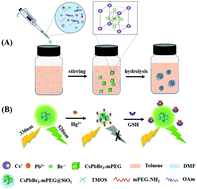Polymer surface ligand and silica coating induced highly stable perovskite nanocrystals with enhanced aqueous fluorescence for efficient Hg2+ and glutathione detection†
Abstract
The poor stability and aqueous-quenching of fluorescence of perovskite nanocrystals (NCs) hinder their application in bio-detection and bio-imaging. Herein, through the synergistic effects of polymer surface ligand and silica encapsulation, highly stable and enhanced aqueous fluorescent CsPbBr3-mPEG@SiO2 NCs were synthesized and used as a novel “on–off–on” fluorescent probe for highly sensitive and selective detection of mercury ions (Hg2+) and glutathione (GSH) in aqueous solutions. The effects of the methoxypolyethylene glycol amine (mPEG-NH2) ligand and silica encapsulation on the stability and aqueous fluorescence of the CsPbBr3 NCs were studied. It indicated that the aqueous fluorescence of perovskite NCs was increased by 2.59 times. The water stability was also greatly improved, with the NCs maintaining 73% of their original fluorescence after storage for 30 days in water. X-ray diffraction (XRD), transmission electron microscopy (TEM) and Fourier transform infrared spectroscopy (FT-IR) analyses further demonstrated that the NCs were successfully passivated by mPEG-NH2 and silica. The fluorescence of the CsPbBr3-mPEG@SiO2 nanocrystals was effectively quenched by Hg2+ which is attributed to the electron transfer process between NCs and Hg2+. Then, through the interaction between Hg2+ and GSH, the restoration of fluorescence for CsPbBr3-mPEG@SiO2 was realized. The “on–off–on” fluorescent probe can be used for the detection of Hg2+ and GSH with a low detection limit of 0.08 nM and 0.19 μM, respectively. It also shows a fast response time and high accuracy for practical sample detection. The simple and sensitive fluorescent probe of CsPbBr3-mPEG@SiO2 shows great potential in environmental and biological sensing.

- This article is part of the themed collection: Analyst HOT Articles 2021


 Please wait while we load your content...
Please wait while we load your content...